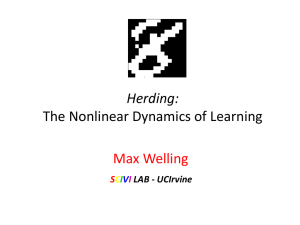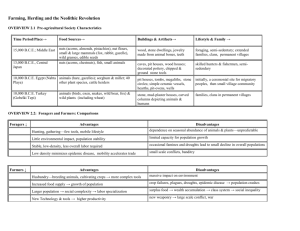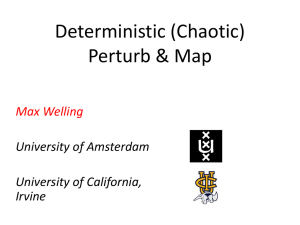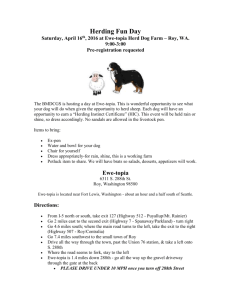Klein_pres - Viessmann European Research Centre
advertisement
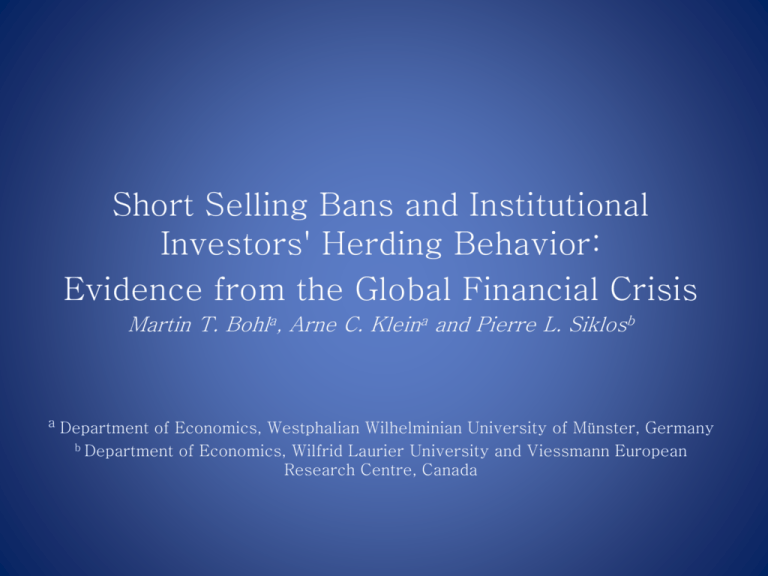
Short Selling Bans and Institutional
Investors' Herding Behavior:
Evidence from the Global Financial Crisis
Martin T. Bohla, Arne C. Kleina and Pierre L. Siklosb
a Department of Economics, Westphalian Wilhelminian University of Münster, Germany
b
Department of Economics, Wilfrid Laurier University and Viessmann European
Research Centre, Canada
Testable Hypotheses
• Does herding become more relevant during a
financial crisis? In other words, are regulators
desired to displace SS during a crisis because
herding is exacerbated during falling markets?
– YES? Herding implies investors’ difference of
opinion is relatively small
– NO? Divergences of opinion increase during a
crisis. Therefore, adverse herding is a possibility
• SENTIMENT plays a role
• Is the evidence for/against herding similar
across countries?
Contribution to the literature
• Do short sales constraints (SSC) have a significant
impact on herding behavior?
Contribution to the literature
• Do short sales constraints (SSC) have a significant
impact on herding behavior?
• The answer, in turn, entails important information for
stock market regulators
Contribution to the literature
• Do short sales constraints (SSC) have a significant
impact on herding behavior?
• The answer, in turn, entails important information for
stock market regulators
• and deepens insights into institutional investors’ trading
behavior
Markets under consideration
Setting and Data: Short Sale Constraints in
The United States
• 07/15/2008 – 08/12/2008
Naked short sales in (18) selected stocks
United Kingdom
• 09/19/2008 - 01/16/2009
All economic short positions in (32) selected stocks
Germany
• 09/22/2008 – 01/31/2010
Naked short sales in (10) selected stocks
Markets under consideration
France
• 09/22/2008 – 01/31/2010
Short Sales in (12) selected stocks
South Korea
• 09/30/2008
All short sales
• 06/01/2009
Lifted for non-financials
Markets under consideration
Australia
• 09/22/2008
Naked short sales
• 11/19/2008
Lifted for non-financials being member of the
S&P/ASX 200 and APRA-regulated business
• 05/24/2009
Ban expires
Markets under consideration
US
UK
GER
FR
ROK
AUS
No. Stocks
banned
(N)
18
29
10
12
16
44
No. Stock
Control
group
18
29
10
12
16
44
T
17
83
343
347
317
127
Markets under consideration
Institutional investors holdings
GDP
• US & UK > 200%
• GER, FR, AUS > 100%
• ROK ≈ 90%
In 2007 (Gonnard (2008))
Literature Review
• Miller (1977), Diamond and Verrecchia (1987)
• Short selling bans
Miller (1977)
• Divergence of opinion
Miller (1977)
• Divergence of opinion
• SSC deter pessimists from expressing their beliefs
Miller (1977)
• Divergence of opinion
• SSC deter pessimists from expressing their beliefs
• therefore, market prices are build upon optimists’
valuation
Miller (1977)
• Divergence of opinion
• SSC deter pessimists from expressing their beliefs
• therefore, market prices are build upon optimists’
valuation
Overvaluation
Diamond and Verrecchia (1987)
SSC reduce informational efficiency:
new information is impounded into prices with a delay
Diamond and Verrecchia (1987)
SSC reduce informational efficiency:
new information is impounded into prices with a delay
• this holds for both positive and negative news
Diamond and Verrecchia (1987)
SSC reduce informational efficiency:
new information is impounded into prices with a delay
• this holds for both positive and negative news
• but the effect is stronger for negative information
Crisis related Bans
Previous literature on the short selling bans reports strong
evidence for deteriorations in market quality and liquidity
• Bris (2008), Boulton and Braga-Alves (2010) and
Kolanski et al. (2010) for the July/August ban in the US
•
Boehmer et al. (2009) and Kolanski et al. (2010) for the
September/October ban in the US
Crisis related Bans
• Marsh and Payne (2010) for the UK
• Helmes et al. (2010) for Australia
• A broad international perspective incl. 30 countries is
given in Beber and Pagano (2011)
Beber and Pagano (2011)
• Their results for 30 countries underscore negative
effects on market liquidity
Beber and Pagano (2011)
• Their results for 30 countries underscore negative
effects on market liquidity
• In addition, they find increased autocorrelations in the
residuals of market model regressions
Empirical Approach
• We aim at identifying the impact of short sale
constraints on herding behavior
Empirical Approach
• We aim at identifying the impact of short sale
constraints on herding behavior
1. A measure of herding is needed
Empirical Approach
• We aim at identifying the impact of short sale
constraints on herding behavior
1. A measure of herding is needed
2. Control for the effects of the crisis per se is
needed
Empirical Approach
• We aim at identifying the impact of short sale
constraints on herding behavior
1. A measure of herding is needed
2. Control for the effects of the crisis per se is
needed
3. Robust inference based on small/medium size
samples
Measure of Dispersion
Measure of Dispersion as an
input to evaluate Herding: details
Measure of Dispersion
• St = dispersion: captures
a key characteristics of
herd behavior
– N = number of stocks,
– T = number of
observations
– rit = return, stock i, time
t;
– rmt = cross-sectional
weighted average of
returns in a ‘portfolio’ of
N stocks
NOT an
E(r)
Average deviation of a stock from the market
proxies how investors discriminate between stocks
Christie and Huang (1995)
Rational Pricing
Herding
Adverse Herding
Methodology: Regression Form
(2)
> 0
under rational
Asset pricing;
{e.g., changing
may be one
reason}
BANNED CONTROL
IMPLIES SSR have
an effect
0 means
deviation from rational
Asset pricing
Proxies variance since
2
2
2
mt
E (rmt
) E (rmt )2 E (rmt
)
Chang et al. (2000)
Autocorrelation:
Schwert’s criterion
From max to min,
use a 10% criterion
Matching
•
Matching variables: Market capitalization, trading
volume and market beta (all standardized)
Matching
•
•
Matching variables: Market capitalization, trading
volume and market beta (all standardized)
Matching metric: Sum of squared differences in those
three variables (Euclidean distance)
Interpretation
In general, evidence supporting an effect of short sale
constraints is found if the estimate for
significantly differs between test and control
groups
Interpretation
In particular, support for regulators’ point of view is
given in case of a dampening effect of SSC on herding
which, in turn, is found if is significantly negative
for the control group while being equal to zero for the
banned stocks.
Control
0
Test
0
Interpretation
By contrast, evidence in line with a amplifying effect
of SSC on herding, is found if is negative for the
test group but equal to zero for the control stocks.
Control
0
Test
0
Bootstrap
A bootstrap algorithm
• enables us to draw reliable inference from small and
medium samples
Bootstrap
A bootstrap algorithm
• enables us to draw reliable inference from small and
medium samples
• allows us to directly test the H0 of Rational Asset
Pricing (i.e., CAPM-type)
Bootstrap
We generate data by the following processes
1.
r r
i ,t
i
i m ,t
i ,t
Bootstrap
We generate data by the following processes
r r
1.
2.
i ,t
i
i m ,t
i ,t
r r SMB HML
i ,t
i
i m ,t
i
i
i ,t
Further empirical issues
• Persistently rising vs falling markets
may make a difference: sort St, by
length of runs l {1,2}
Further empirical issues
• Persistently rising vs falling markets
may make a difference: sort St, by
length of runs l {1,2}
• Threshold effects?
Further empirical issues
• Persistently rising vs falling markets
may make a difference: sort St, by
length of runs l {1,2}
• Threshold effects?
• Small cap versus large cap: former
exhibit more herding than latter;
former lag latter in terms of
correlation of returns
Empirical Results
Recall that we bootstrap deviations from Rational
Asset Pricing
Empirical Results
Recall that we bootstrap deviations from Rational
Asset Pricing
• Significance does not mean significantly different
from zero
Empirical Results
Recall that we bootstrap deviations from Rational
Asset Pricing
• Significance does not mean significantly different
from zero
• but significantly different from the value implied by
the asset pricing model
Empirical Results
Adverse Herding!
Herding
Empirical Results
Empirical Results
• Almost no herding (either adverse or regular) in
case of unbanned stocks
Empirical Results
• Almost no herding (either adverse or regular) in
case of unbanned stocks
• strong evidence for adverse herding for the stocks
subject to the constraints for some countries
Interpretation
• It is well known in the literature that short sale
constraints create uncertainty about fundamental asset
values
Interpretation
• It is well known in the literature that short sale
constraints create uncertainty about fundamental asset
values
• The work of Hwang and Salmon (2004, 2009) suggests
that during such turmoils investors loose trust in the
market consensus and come back to fundamental based
pricing
Interpretation
• It is well known in the literature that short sale
constraints create uncertainty about fundamental asset
values
• The work of Hwang and Salmon (2004, 2009) suggests
that during such turmoils investors loose trust in the
market consensus and come back to fundamental based
pricing
• This may show up in adverse herding, via an increased
dispersion of returns
Thank you for your attention!
